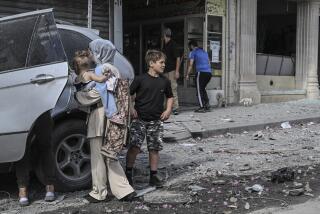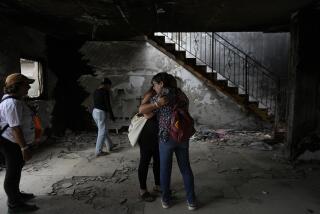Martyrdom: The Most Powerful Weapon
- Share via
There is indeed a connection between the suicide bombing of the U.S. warship Cole in Yemen last September and renewed Palestinian-Israeli violence. However, it is not the one insinuated in some of the early reporting, namely that the attack was meant to punish the U.S. for its support of Israel’s new “aggression” against the Palestinians. Rather, they are new steps in a radical campaign to expel “colonialists” from the Middle East by challenging the foundation of their superiority--their military power.
The unmistakable message of the bombing of the Cole and the Palestinian offensive is the powerlessness of the superpowers, be they regional or global, in the face of Islam’s embrace of martyrdom.
For instance, the al Hayat newspaper, quoting Arab sources close to the Afghanistan-based terrorist Osama bin Laden, reported Nov. 4 that “Bin Laden knelt and thanked Allah for this operation [against the Cole], which has shaken the American military reputation.”
In some respects, the Palestinian strategy is the logical culmination of the suicide attacks, including the one against the Cole, that were all too common to the Middle East in the past two decades. Now, the Palestinian message is that Israel is confronting a martyr “nation,” not just individual fanatics or militant groups. As one Palestinian commander told the Israeli daily Haaretz: “Our ability to die is greater than the Israelis’ ability to go on killing us.”
Even Israeli Prime Minister Ehud Barak seems convinced this is the case. He told Israel Radio on Nov. 15, “If we thought that instead of 200 Palestinian fatalities, 2,000 dead would put an end to the fighting at a stroke, then we would use much more force. But in our opinion the opposite is true, and the state of Israel would then be in a much more complicated situation.”
Either way, the idea is to convince the militants’ superior enemies--that is, the U.S. and Israel--of the futility of their defenses in the face of a weaker rival’s proven readiness to fight to the end. That a billion-dollar destroyer armed for 21st century warfare was all but destroyed by a small boat apparently manned by a couple of “martyrs” conveys this message.
Similarly, the inability of the Israel Defense Forces to stop the violence by lightly armed and ill-trained Palestinian gunmen speaks volumes. Although, as Israeli Army Col. Boaz Cohen of the Ground Forces Command told the Jerusalem Post on Nov. 12, “All of the [Israel Defense Forces’] conscript battle order is currently dealing with the conflict in Judea, Samaria and the Gaza Strip.” In both cases the radical message is simple: “We won’t be deterred!”
In addition, the radicals, fully aware of the sensitivity of democratic governments to combat losses, aim to use the martyr strategy to exact enemy casualties at any price. The zeal of the martyr is also meant to intimidate and demoralize the enemy, while simultaneously acting as a role model and inspiration to his own people.
Victimhood is promoted as a means of mass mobilization. Further, the greater the number of victims one can claim, the stronger the impact on world opinion. Thus, a stronger enemy would hesitate to use his overwhelming superiority to achieve a decisive military outcome.
There are various reasons for this strategy’s growing appeal. For example, the decline of secular nationalism in the Arab world in favor of the Islamization of simmering conflicts, such as the one between the Palestinians and the Israelis, have certainly played a role.
But the one factor that has not received much attention is the impact of the growing disparity in power between high-tech armies, like the U.S. military and the IDF on the one side, and most of the other armed forces in the Middle East on the other. It is no coincidence that at a time when modern armies are equipped to quickly reach decisive military outcomes via pinpoint attacks on military and strategic targets, others in the Middle East are increasingly turning to protracted low-intensity warfare.
Although modern armies are increasingly preparing to destroy the enemy’s ability to fight, weaker forces are concentrating on draining their enemies’ will to fight. Instead of the limited and quick war designed to bring the conflict back to the negotiating table, the weaker forces are seeking total war, encompassing all segments of society. Hafiz Barghouti, editor of the Palestinian Authority’s daily al-Hayat al-Jadidah, wrote on Oct. 27 that Palestinians who refuse to endanger their children are nothing less than traitors. Indeed, the tendency of modern armies to respond to Islamic violence by employing advanced standoff or long-range weaponry--such as the U.S. Tomahawk cruise missile attack on Bin Laden’s compounds in Afghanistan in August 1998 and the IDF’s repeated use of helicopter gunships, gunboats and anti-tank missiles against Palestinian targets--may be counterproductive. Besides the negative international reaction they invoke, militant leaders have portrayed such tactics as indicative of the strong aversion to casualties of the U.S. military and the IDF.
As the techno-military gap grows, the martyr model of warfare will likely become the main strategic challenge facing the U.S. in the 21st century. At a minimum, it makes necessary the wholesale rethinking of deterrence as it has been exercised since World War II.
But time is short. What is already unfolding in the Middle East is a calculated effort to embrace irrationality, as the West sees it, as the weapon of choice. Considering that several extremist regimes in the Middle East already possess weapons of mass destruction or are about to, the entrenchment of a culture glorifying human sacrifice could trigger a real catastrophe.
More to Read
Sign up for Essential California
The most important California stories and recommendations in your inbox every morning.
You may occasionally receive promotional content from the Los Angeles Times.










